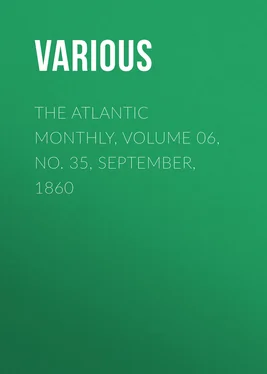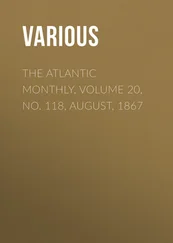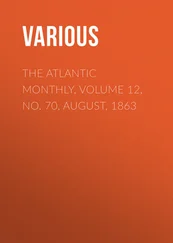Various - The Atlantic Monthly, Volume 06, No. 35, September, 1860
Здесь есть возможность читать онлайн «Various - The Atlantic Monthly, Volume 06, No. 35, September, 1860» — ознакомительный отрывок электронной книги совершенно бесплатно, а после прочтения отрывка купить полную версию. В некоторых случаях можно слушать аудио, скачать через торрент в формате fb2 и присутствует краткое содержание. Жанр: foreign_antique, periodic, foreign_edu, на английском языке. Описание произведения, (предисловие) а так же отзывы посетителей доступны на портале библиотеки ЛибКат.
- Название:The Atlantic Monthly, Volume 06, No. 35, September, 1860
- Автор:
- Жанр:
- Год:неизвестен
- ISBN:нет данных
- Рейтинг книги:5 / 5. Голосов: 1
-
Избранное:Добавить в избранное
- Отзывы:
-
Ваша оценка:
- 100
- 1
- 2
- 3
- 4
- 5
The Atlantic Monthly, Volume 06, No. 35, September, 1860: краткое содержание, описание и аннотация
Предлагаем к чтению аннотацию, описание, краткое содержание или предисловие (зависит от того, что написал сам автор книги «The Atlantic Monthly, Volume 06, No. 35, September, 1860»). Если вы не нашли необходимую информацию о книге — напишите в комментариях, мы постараемся отыскать её.
The Atlantic Monthly, Volume 06, No. 35, September, 1860 — читать онлайн ознакомительный отрывок
Ниже представлен текст книги, разбитый по страницам. Система сохранения места последней прочитанной страницы, позволяет с удобством читать онлайн бесплатно книгу «The Atlantic Monthly, Volume 06, No. 35, September, 1860», без необходимости каждый раз заново искать на чём Вы остановились. Поставьте закладку, и сможете в любой момент перейти на страницу, на которой закончили чтение.
Интервал:
Закладка:
There are not many trees that assume the shape of an obelisk, or a long spire; but Nature, who presents to our eyes an ever-charming variety of forms as well as hues, in the objects of her creation, has given us the figure of the obelisk in the Chinese Juniper, in the Balsam Fir, in the Arbor-Vitæ, and lastly in the Lombardy Poplar, which may be offered to exemplify this class of forms. The Lombardy Poplar is interesting to thousands who were familiar with it in their youth, as an ornament to road-sides and village inclosures. It was formerly a favorite shade-tree, and still retains its privileges in many old-fashioned places. A century ago great numbers of Poplars were planted on the village way-sides, in front of dwelling-houses, on the borders of public grounds, and particularly on the sides of lanes and avenues leading to houses situated at a short distance from the high-road. Hence a row of these trees becomes suggestive at once of the approach to some old mansion or country-seat, which has now, perhaps, been converted into a farm-house, having exchanged its proud honors of wealth for the more simple and delightful appurtenances of rustic independence.
Some of these ancient rows of Poplars are occasionally seen in old fields, where almost all traces of the habitation which they were intended to grace are obliterated. There is a melancholy pleasure in surveying these humble ruins, whose history would illustrate the domestic habits of our ancestors. The cellar of the old house is now a part of the pasture-land, and its form can be traced by the simple swelling of the turf. Sumachs and Cornel-bushes have usurped the place of the exotic shrubbery in the old garden; and the only ancient companions of the Poplars, now remaining, are here and there a straggling Lilac or Currant-bush, a tuft of Houseleek, and perhaps, under the shelter of some dilapidated wall, the White Star of Bethlehem is seen meekly glowing in the rude society of the wild-flowers.
The Lombardy Poplar, which was formerly a favorite way-side ornament, a sort of idol of the public, and, like many another idol, exalted to honors that exceeded its merits, fell suddenly into unpopularity and disgrace. After having been admired and valued as if its leaves were all emeralds and its buds apples of gold, it was spurned and ridiculed and everywhere cut down as a cumberer of the ground. The faults attributed to it did not belong to the tree, but were the effects of the climate into which it had been removed. It was brought from the sunny vales of Italy, where it had been delicately reared by the side of the Orange and the Myrtle, and transplanted into the cold climate of New England. The tender constitution of this tree could not endure our rude winters; and every spring witnessed the decay of a large portion of its small branches. Hence it became prematurely aged, and in its decline carried with it the marks of its infirmities.
But, with all these imperfections, the Lombardy Poplar was more worthy of the honors it received from our predecessors than of its present disrepute. It is one of the fairest of trees, in the vigor of its health and the greenness of its youth. But nearly all the old Poplars are extirpated, and but few young trees are coming up to supply their places. While I am now writing, I see from my window the graceful spire of one solitary tree, towering above the surrounding objects in the landscape, and yielding to the view something of an indescribable charm. There it stands, the symbol of decayed reputation, in its old age still retaining the primness of its youth; neither drooping in its infirmities under the weight of their burden, nor losing in its desertedness the fine lustre of its foliage; and in its disgrace still bearing itself proudly, as if conscious that its former honors were deserved, and not forgetting that dignity which becomes one who has fallen without dishonor.
There is no other tree that so pleasantly adorns the sides of narrow lanes and avenues, or so neatly accommodates itself to limited inclosures. Its foliage is dense and of the liveliest green, tremulous, and making delicate music to the light fingers of every breeze; its terebinthine odors scent the soft vernal wind that enters your open windows with the morning sunshine; its branches, always tending upward, closely gathered together, and slenderly formed, afford a harbor to the singing-birds, who revel among them as a favorite resort; and its long tapering spire, that points to heaven, gives an air of cheerfulness and religious tranquillity to village scenery.
Of the drooping trees, the Weeping Willow is the most conspicuous example, unless we except the American Elm; but a remarkable difference may be observed in the drooping character of these two trees. In the Elm we perceive a general arching or curvature of all its branches, from their points of junction with the tree to their extremities; so that two rows of Elms, meeting over an avenue, would represent, more nearly than any other trees disposed in the same manner, the vault of a Gothic arch. A double row of Weeping Willows would make no such figure by the meeting of their branches. The Weeping Willow extends its long arms in lines more nearly straight, not originating, as in the Elm, for the most part, from one common centre of junction, but joining the shaft of the tree at different points;—hence the drooping character of this tree is observed only in its long, slender, and terminal spray.
The Weeping Willow is one of the most poetical of trees, being consecrated to the Muse by the part which has been assigned it in many a scene of romance, and by its connection with events recorded in Holy Writ. It is invested with a poetical interest by its symbolical representation of sorrow in the pendulous character of its spray, by its fanciful uses as a garland for disappointed lovers, and by the employment of it in burying-grounds, and in pictures as drooping over graves. We remember it in sacred history by its association with the rivers of Babylon, with the tears of the Children of Israel, and with the forsaken harps of their sorrowing minstrels, who hung them upon its branches. It is distinguished by the graceful beauty of its outlines, its light-green delicate foliage, its sorrowing attitude, and its gently waving spray, all in sweet accordance with its picturesque, poetic, and Scriptural associations.
Hence the Weeping Willow never fails to give pleasure to the sight even of the most insensible observer. There are not many whose minds are so obtuse as to be blind to its peculiarly graceful attitude and motions, and every one is familiar with its history, as recorded in poetry and romance, all the incidents of which have served to elevate it above any association with fashion or vulgarity. When we see it waving its long branches neatly over some private inclosure, overshadowing the gravelled walk and the flower-garden,—or watching pensively over the graves of the dead, where the light hues of its foliage help to soften the glowing fancies which are apt to arise from our meditations among the tombs,—or on some wide common, giving solace to the passing traveller, and inviting the playful children to its shade,—or trailing its sweeping spray, like the tresses of a Naiad, over some silvery pond or gently flowing stream,—it is in all cases a delightful object, always picturesque, always soothing, inspiring, and sacred to memory, and serving, by its alliance with what is hallowed in literature, to bind us more closely to Nature.
Above all the trees of the New World, the Elm deserves to be considered the sovereign tree of New England. It is abundant both in field and forest, and forms the most remarkable feature in our cleared and cultivated grounds. Though the Elm is found in almost all parts of the country, in no other is it so conspicuous as in the Northeastern States, where, from the earliest settlement of the country, it has been planted as a shade-tree, and has been valued as an ornament above the proudest importations from a foreign clime. It is the most remarkable of the drooping trees except the Willow, which it surpasses in stateliness and in the variety of its growth.
Читать дальшеИнтервал:
Закладка:
Похожие книги на «The Atlantic Monthly, Volume 06, No. 35, September, 1860»
Представляем Вашему вниманию похожие книги на «The Atlantic Monthly, Volume 06, No. 35, September, 1860» списком для выбора. Мы отобрали схожую по названию и смыслу литературу в надежде предоставить читателям больше вариантов отыскать новые, интересные, ещё непрочитанные произведения.
Обсуждение, отзывы о книге «The Atlantic Monthly, Volume 06, No. 35, September, 1860» и просто собственные мнения читателей. Оставьте ваши комментарии, напишите, что Вы думаете о произведении, его смысле или главных героях. Укажите что конкретно понравилось, а что нет, и почему Вы так считаете.












